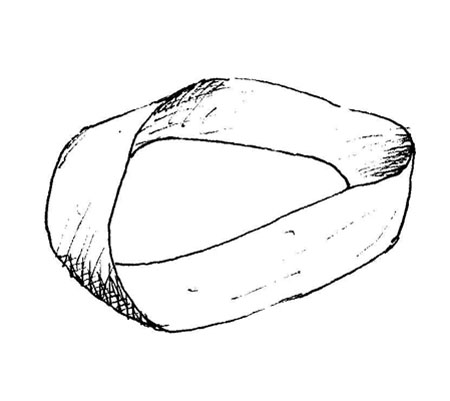 If
the self in cyberspace realizes a Möbius strip
topology it is because space has collapsed and
the subject with/in it—the posthuman—has been reduced to a point of view
so that only his “consciousness moves through the screen [. . .] leaving
behind the body as an unoccupied shell” (Hayles 38). Metaphorizing the
posthuman as a singularity also has tremendous implications since the
subject may be free to rewrite himself without the constraints of physical
laws. Both POV and singularity are supported by a Möbius strip
topology since the Möbius strip allows one
to discuss the nature of language in psychoanalysis and cybernetics,
specifically, the immediacy between signifiers in human and machine; their
souls are entwined but the connections do not appear to have any length.
I would like to consider this topology in an effort to modify Lacan’s
discourse of the Analyst. By replacing the master signifier in his
formula with Hayles’s flickering signifier of cyberspace one arrives at
a “proof” for hypertext’s heuristic capacity; the proof, in turn, ultimately
rests upon a Möbius foundation. Another way to state this idea
is that the post-poststructuralist nature of the flickering signifier
as well as the posthuman amalgam of self and cyberspace yields change;
the subject may better alter a signifier that is that much more removed
from its signified, but in time only. A closer look at what is meant
here by “post-poststructuralist” will help us. If
the self in cyberspace realizes a Möbius strip
topology it is because space has collapsed and
the subject with/in it—the posthuman—has been reduced to a point of view
so that only his “consciousness moves through the screen [. . .] leaving
behind the body as an unoccupied shell” (Hayles 38). Metaphorizing the
posthuman as a singularity also has tremendous implications since the
subject may be free to rewrite himself without the constraints of physical
laws. Both POV and singularity are supported by a Möbius strip
topology since the Möbius strip allows one
to discuss the nature of language in psychoanalysis and cybernetics,
specifically, the immediacy between signifiers in human and machine; their
souls are entwined but the connections do not appear to have any length.
I would like to consider this topology in an effort to modify Lacan’s
discourse of the Analyst. By replacing the master signifier in his
formula with Hayles’s flickering signifier of cyberspace one arrives at
a “proof” for hypertext’s heuristic capacity; the proof, in turn, ultimately
rests upon a Möbius foundation. Another way to state this idea
is that the post-poststructuralist nature of the flickering signifier
as well as the posthuman amalgam of self and cyberspace yields change;
the subject may better alter a signifier that is that much more removed
from its signified, but in time only. A closer look at what is meant
here by “post-poststructuralist” will help us. |
 If
the self in cyberspace realizes a Möbius strip
topology it is because space has collapsed and
the subject with/in it—the posthuman—has been reduced to a point of view
so that only his “consciousness moves through the screen [. . .] leaving
behind the body as an unoccupied shell” (Hayles 38). Metaphorizing the
posthuman as a singularity also has tremendous implications since the
subject may be free to rewrite himself without the constraints of physical
laws. Both POV and singularity are supported by a Möbius strip
topology since the Möbius strip allows one
to discuss the nature of language in psychoanalysis and cybernetics,
specifically, the immediacy between signifiers in human and machine; their
souls are entwined but the connections do not appear to have any length.
I would like to consider this topology in an effort to modify Lacan’s
discourse of the Analyst. By replacing the master signifier in his
formula with Hayles’s flickering signifier of cyberspace one arrives at
a “proof” for hypertext’s heuristic capacity; the proof, in turn, ultimately
rests upon a Möbius foundation. Another way to state this idea
is that the post-poststructuralist nature of the flickering signifier
as well as the posthuman amalgam of self and cyberspace yields change;
the subject may better alter a signifier that is that much more removed
from its signified, but in time only. A closer look at what is meant
here by “post-poststructuralist” will help us.
If
the self in cyberspace realizes a Möbius strip
topology it is because space has collapsed and
the subject with/in it—the posthuman—has been reduced to a point of view
so that only his “consciousness moves through the screen [. . .] leaving
behind the body as an unoccupied shell” (Hayles 38). Metaphorizing the
posthuman as a singularity also has tremendous implications since the
subject may be free to rewrite himself without the constraints of physical
laws. Both POV and singularity are supported by a Möbius strip
topology since the Möbius strip allows one
to discuss the nature of language in psychoanalysis and cybernetics,
specifically, the immediacy between signifiers in human and machine; their
souls are entwined but the connections do not appear to have any length.
I would like to consider this topology in an effort to modify Lacan’s
discourse of the Analyst. By replacing the master signifier in his
formula with Hayles’s flickering signifier of cyberspace one arrives at
a “proof” for hypertext’s heuristic capacity; the proof, in turn, ultimately
rests upon a Möbius foundation. Another way to state this idea
is that the post-poststructuralist nature of the flickering signifier
as well as the posthuman amalgam of self and cyberspace yields change;
the subject may better alter a signifier that is that much more removed
from its signified, but in time only. A closer look at what is meant
here by “post-poststructuralist” will help us. 